Human Rights Careers has conducted a survey with 138 human rights consultants around the globe. The results reveal how much consultants earn, where they work, and which factors most influence their rates.
Before we start
Human rights consultants are, at their core, mission-driven. They choose this work because they believe in advancing dignity, justice, and equality – not because it is the most lucrative path.
Yet, in a profession committed to fairness, silence about pay can quietly work against our values. The ability to “not talk about money” is often a privilege. Without transparency, systemic inequities can persist, widening pay gaps across gender, race, geography, and other intersecting identities.
Open conversations about remuneration are not about diminishing our mission – they are about protecting it. Pay transparency can help ensure that opportunities are accessible to people from diverse backgrounds, that career sustainability is possible for those without independent financial means, and that the sector does not unintentionally exclude the very voices it seeks to amplify.
We want to say thank you to everyone who took the time to participate in this survey. By sharing your daily rate and insights, you’ve contributed to nurturing a field where fairness is not just an aspiration but a lived practice – where the principles of equity we often defend for others are reflected within our own professional community. Your input makes this step toward greater transparency and equity possible, helping to shape a human rights sector that is both inclusive and sustainable for all who serve it. Let’s get started!
What type of organization/entity are you working for most frequently?
Over half of respondents (52.2%) reported that NGOs are their most frequent clients, followed by intergovernmental organizations (28.3%), businesses or corporates (8.7%), governments (5.8%), and schools or other entities (5.0%).
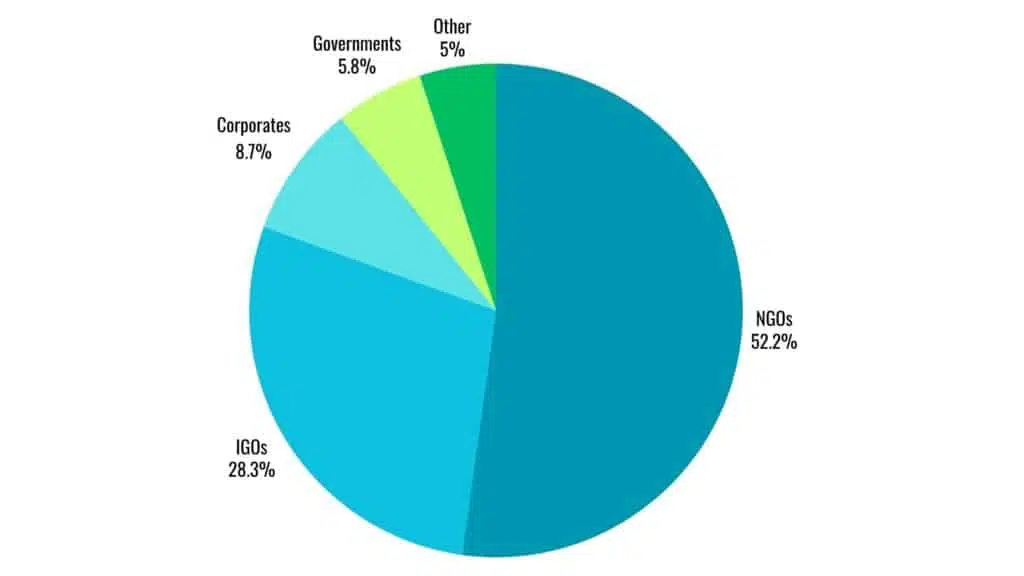
How does the employer influence the daily rate of consultants?
NGOs, while the most frequent employer type, consistently pay less than other entities, with over a third of consultants earning under USD 200/day. IGOs provide steady mid-range compensation, most commonly between USD 201–600/day, with only small shares at the extremes. Governments spread compensation broadly but remain clustered in the mid-range. Businesses stand out for their polarization: some consultants earn less than USD 100/day, while a significant share secure the highest pay levels above USD 1000/day.
This data shows that private sector and government-linked clients tend to offer the highest pay potential, while NGOs despite being the most common client typically pay only slightly above intergovernmental rates.
- Businesses (+65.6%)
- Governments (+25.7%)
- Nonprofits / NGOs (+4.6%)
- Intergovernmental Organizations
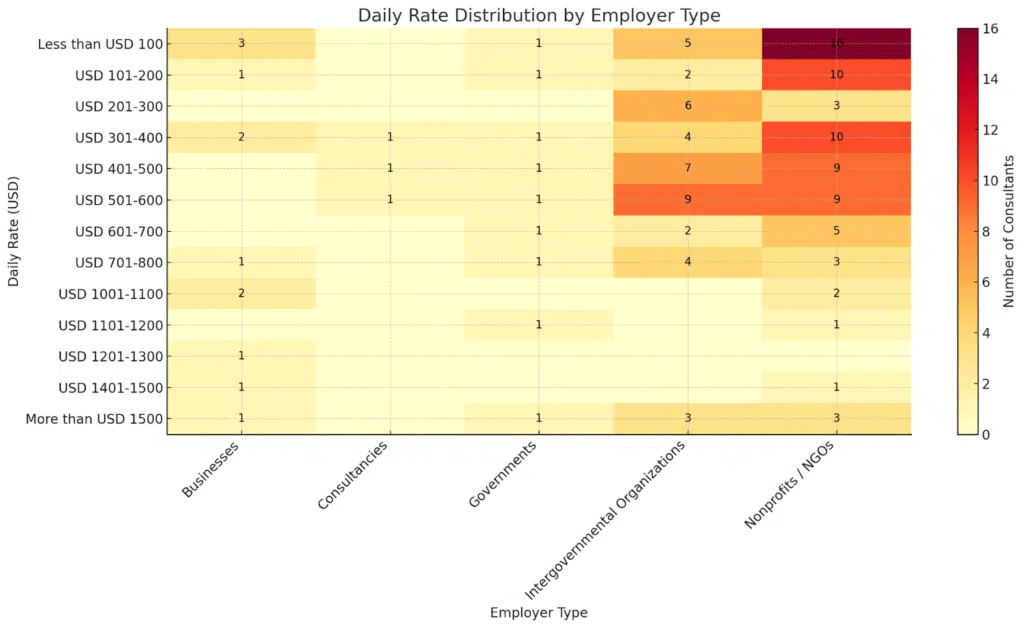
Helpful Context
Especially if you are an early career professional or a career changer, you might be surprised to see IGOs (e.g. UN) paying on the lower end of the mid-ranges. This is due to standardisation of pay in IGOs. While international staff positions (e.g. P2, P3, P4 etc.) are paid exceptionally well, non-staff positions like consultants may earn significantly less, especially if they are hired locally. Below is a screen capture from the ST/AI/2013/4 (for consultants and individual contractors on the international level). This document was also used as reference for my own consultancy work at OHCHR, so it was still relevant in 2023.
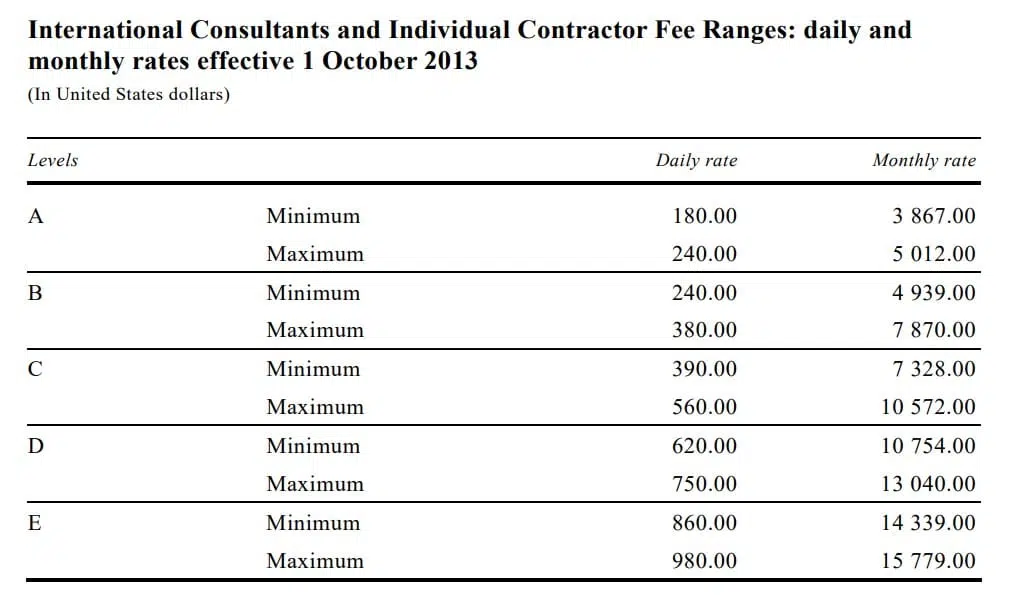
Important Note: Consultants may have to pay up to 55% of their income in taxes depending on where they are tax resident, how much they earn and who is hiring them. This is crucial if you are just getting started as consultant. Make sure you know how much taxes you owe to determine a sustainable rate.
How much do human rights consultants earn per day?
The survey results reveal a clear picture of how much human rights consultants typically earn per day. The most common pay range falls between USD 201 and 600 per day, which accounts for nearly half of all respondents. Within this band, the USD 501-600 range is the single largest category. A smaller group, about 13%, earn between USD 601 and 800 per day.
At the high end of the spectrum, only about one in ten consultants (11%) report earning more than USD 1000 per day. These very high-paying opportunities are the exception rather than the rule.
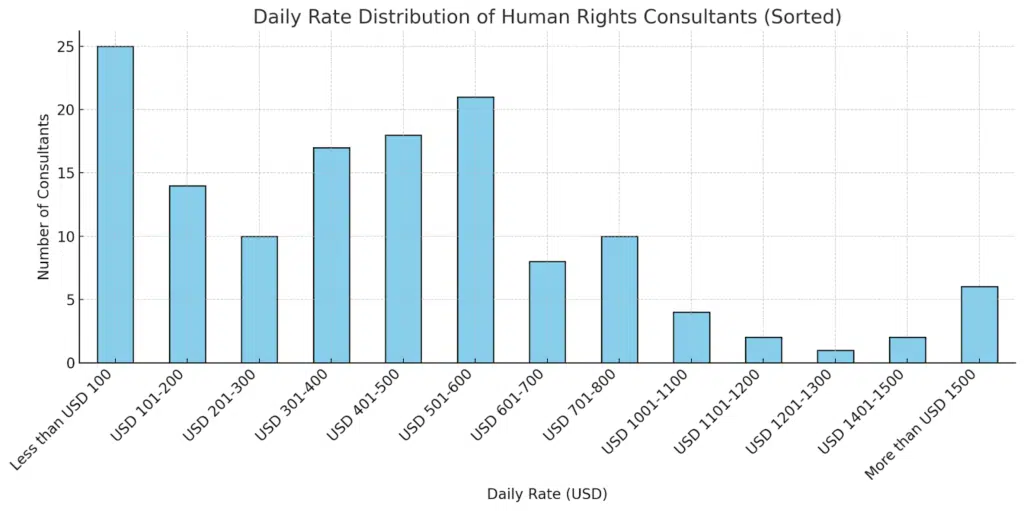
In the table below we have divided the reported incomes into four income groups from lowest to highest. We then calculated the average for each group based on the survey data (using midpoints for ranges to approximate values). This might be helpful when considering if you live in a high- or low-income country working on the national level in conjunction with other criteria such as your experience and the type of employer.
- Lower quartile (25%): earn up to ~USD 150/day
- Median (50%): half of consultants earn up to ~USD 450/day
- Upper quartile (75%): three-quarters earn up to ~USD 550/day
- Top quartile (25%): earn above USD 550/day, with the highest rates reaching USD 1600/day
How much did you earn (before taxes) as a consultant in the last year?
The data shows that human rights consultancy earnings vary widely and range from less than 10,000 to more than USD 200,000 per year.
- Nearly one in three consultants (33%) earned less than USD 10,000 in the past year.
- Another 37% earned between USD 10,000 and 50,000.
- About 19% earned between USD 50,001 and 100,000.
- Only 11% earned above USD 100,000, and a very small group (about 4%) exceeded USD 200,000.
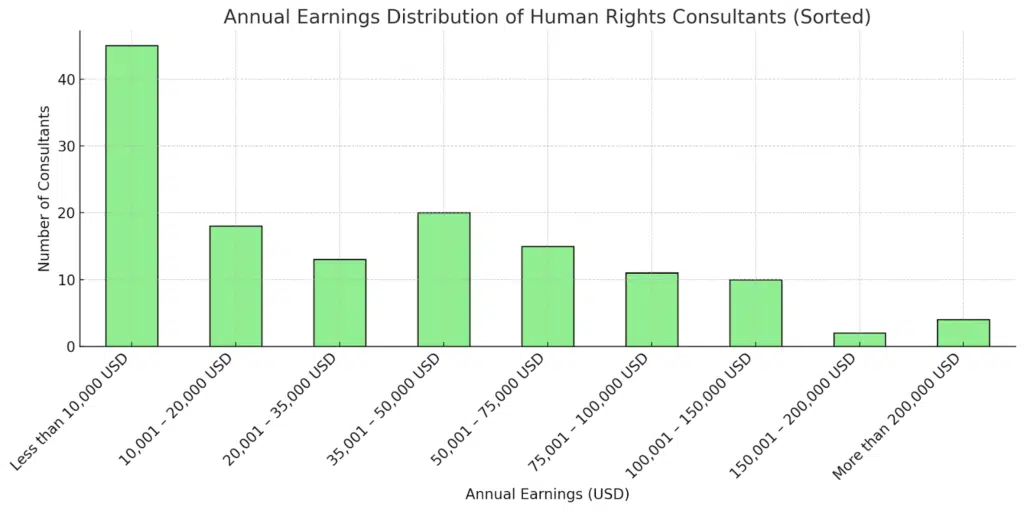
Summary:
- Lower quartile (25%): up to ~USD 5,000/year
- Median (50%): up to ~USD 27,500/year
- Upper quartile (75%): up to ~USD 62,500/year
- Top quartile (25%): above USD 62,500/year, with the very highest reaching over USD 225,000/year
Where are you primarily offering your services?
Of the human rights consultants surveyed we see they divide their work across three main markets: international (44.9%), national (26.8%), and a mix of both (28.3%). This distribution highlights that while many consultants operate globally, a sizeable proportion continue to serve national-level clients or balance between the two.
The data also reveals an earnings advantage for consultants with an international scope. Consultants working exclusively at the national level earn an average of about USD 392 per day. By contrast, those working internationally earn around USD 489 per day, a difference of nearly 25% (+USD 97). Consultants who split their work between national and international clients report the highest averages, at approximately USD 503 per day, or 28% higher than the national-only group (+USD 111).
Looking at distributions rather than averages confirms the trend. Over half (54%) of national-level consultants earn below USD 200/day, while this is true for only 8% of international consultants. The majority of international consultants cluster between USD 201 and 800/day, reflecting more consistent mid-range pay. Interestingly, national-level consultants show a higher share in the very top (>USD 1000/day) compared to international consultants, but this is outweighed by the large proportion at the lower end, pulling their overall average down.
In short, the analysis shows that international or mixed engagement improves earning potential for consultants, raising the overall average by nearly a quarter compared to working nationally alone.
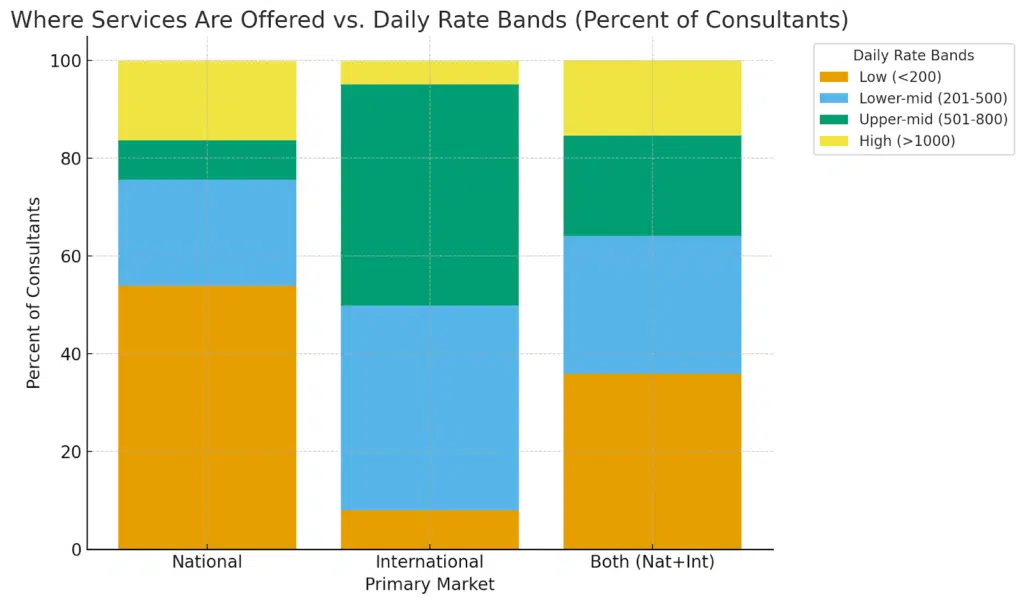
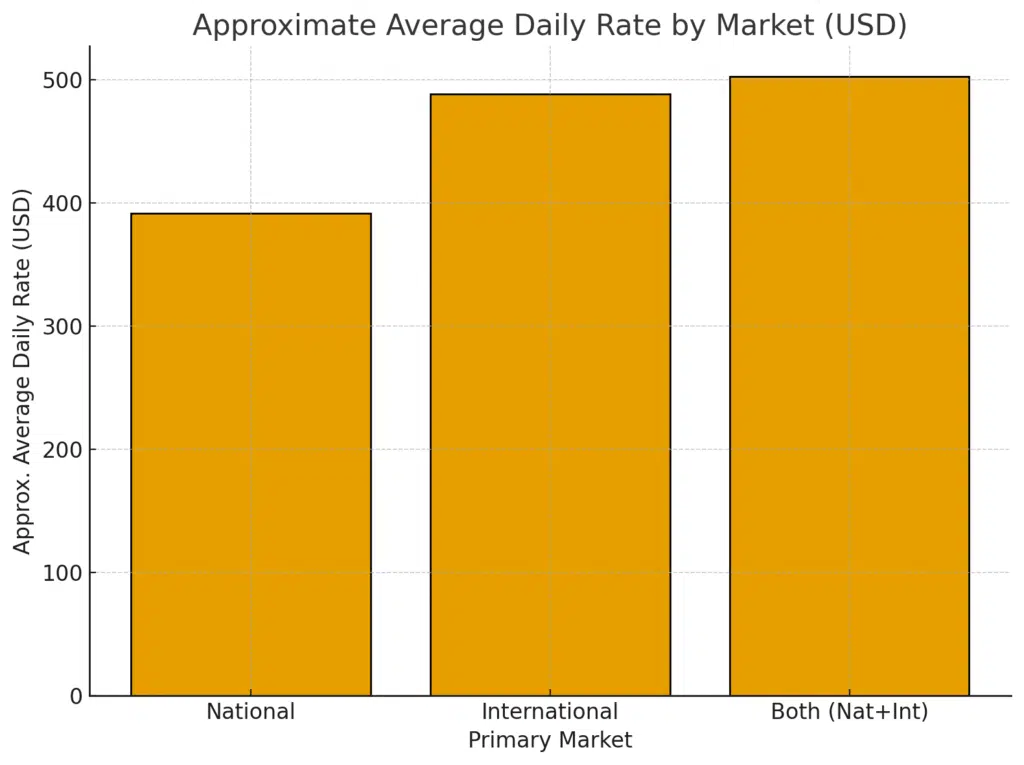
In which area do you primarily provide your consulting services?
The survey reveals a diverse spread of specializations among human rights consultants. The largest share of the survey participants, 26.1%, focus on human rights law and legal services. Another 20.3% work in research and analysis, reflecting the demand for evidence-based advocacy. Significant groups also concentrate on capacity building and technical assistance (15.9%), advocacy and policy engagement (9.4%), and education and training (9.4%).
Smaller but important segments include campaigning and communications (7.2%) and monitoring and evaluation (4.3%), while a further 7.2% provide services that fall into other specialized or mixed categories.
In short, while the legal and research functions dominate, there is considerable diversity across skill areas, reflecting the wide range of expertise needed in the human rights consultancy field.
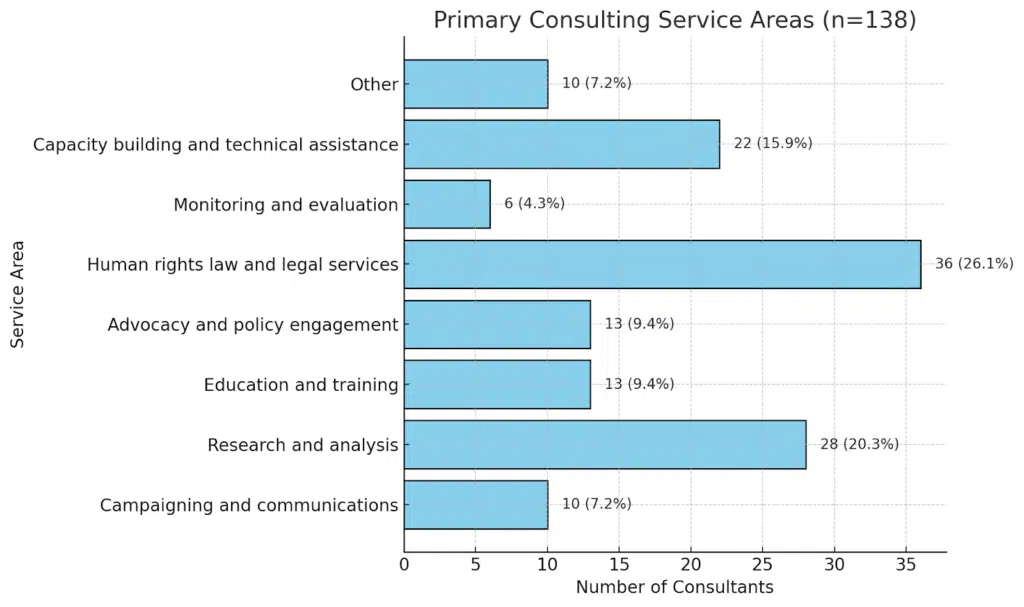
How does the work area influence the daily rate of consultants?
Daily rates vary by work area. Advocacy and monitoring & evaluation show the highest concentration in low rates (< USD 200). Education & training and research & analysis are dominated by the USD 201–500 range, with research also showing a substantial upper-mid (USD 501–800) presence. Capacity building & technical assistance and Other skew toward the upper-mid bands. Human rights law & legal services displays the widest spread, including a notable high-rate (> USD 1000) segment, reflecting a mix of lower paid advisory tasks alongside specialized legal work. Overall, mid-range rates (USD 201–800) account for the bulk of work in most areas, while very high rates are rare and concentrated in law, campaigning, M&E, and some capacity-building roles.
Summary:
- Lowest rates are concentrated in advocacy, monitoring, and campaigning.
- Research and capacity building offer more consistent mid-range pay.
- Human rights law and legal services spans the widest spread, from very low to very high.
- Only a small minority across all areas achieve >USD 1000/day, but they are more common in law, campaigning, and M&E.
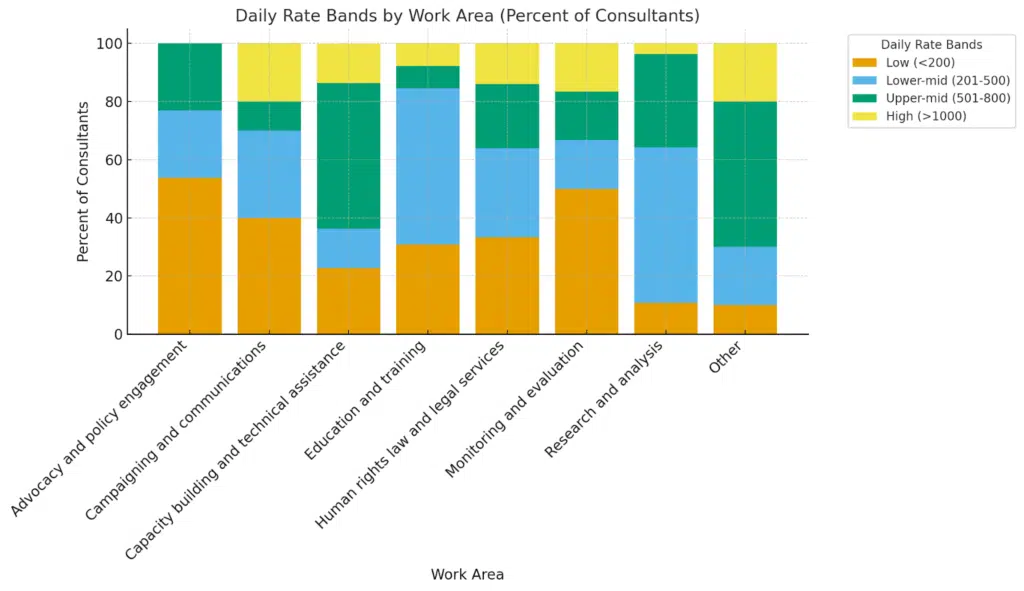
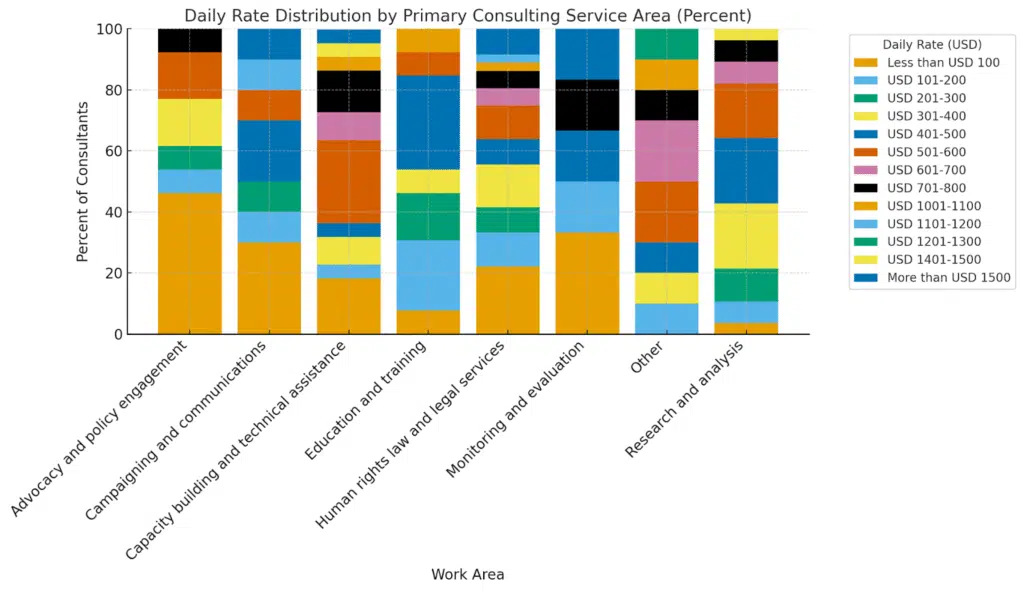
How many years of experience do you have?
The survey shows that human rights consulting is conducted by professionals across the entire career spectrum, though the majority of the survey participants fall into the mid-career range. The single largest group is those with 6-9 years’ experience (23.2%), followed by 10-13 years (15.9%) and 18-21 years (15.2%), suggesting that many consultants establish themselves in the field after building several years of expertise.
At the same time, early-career professionals (0-5 years) make up 20.2% of respondents, highlighting that consulting is not exclusively a later-stage career move but also an entry point into human rights work. More experienced consultants are less common: 13.8% have over 22 years of experience, and just 5.1% have more than 25 years in the field.
Overall, the data reveals a sector that is anchored by mid-career professionals, but with significant participation at both the early and late ends of the spectrum-underscoring the diversity of career paths into consulting.
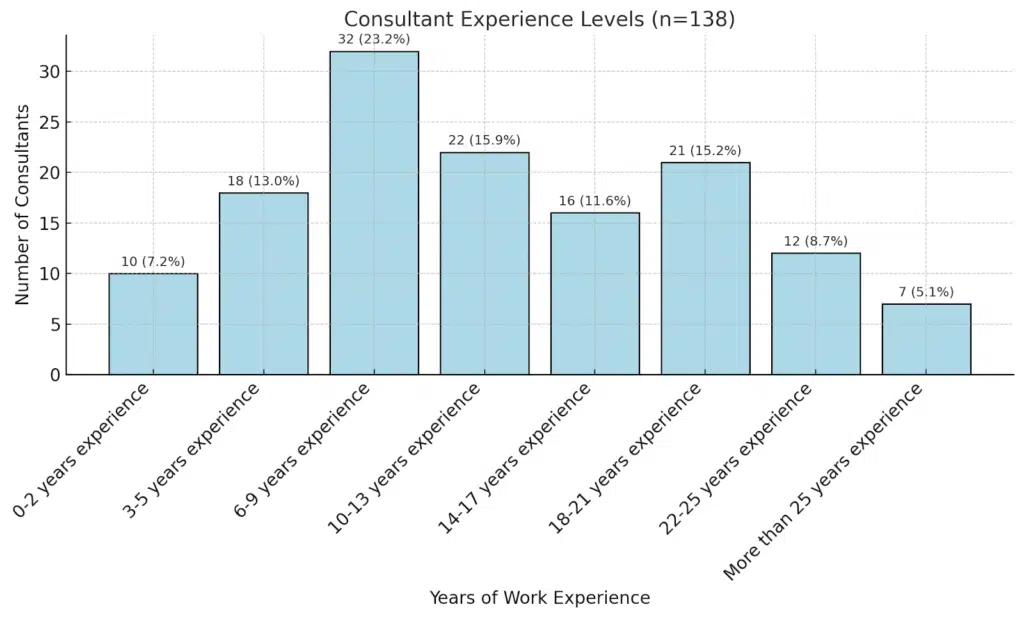
How does work experience influence the daily rate of consultants?
The survey shows that experience influences pay, but the pattern is not a simple linear climb as we expected. Early-career consultants (0-2 years) are the most likely to be in the lowest pay bracket, with 60% earning under USD 100/day. By 3-5 years of experience, the picture changes: only a quarter of consultants are below USD 200/day, while over a third are already in the USD 501-800/day range.
Interestingly, there’s not a perfectly linear increase, those with 3-5 years’ experience report higher daily rates than many mid-career groups (6-13 years), who are mostly concentrated in the USD 201–500/day mid-ranges. This suggests that other factors, such as specialization, client type, or simply sample size effects, play a strong role in shaping earnings. We’d love to hear your assumptions as to why this may be the case.
From 14-21 years experience, consultants are less likely to be at the lower end, with most clustered between USD 401-700/day. Among the most senior consultants (22+ years), the spread widens: some remain in lower brackets, while others move into the high-end tiers above USD 1000/day.
Overall, experience helps consultants avoid the very lowest pay levels, but it does not guarantee progression into the highest ones. Rates remain highly variable, even among senior professionals.
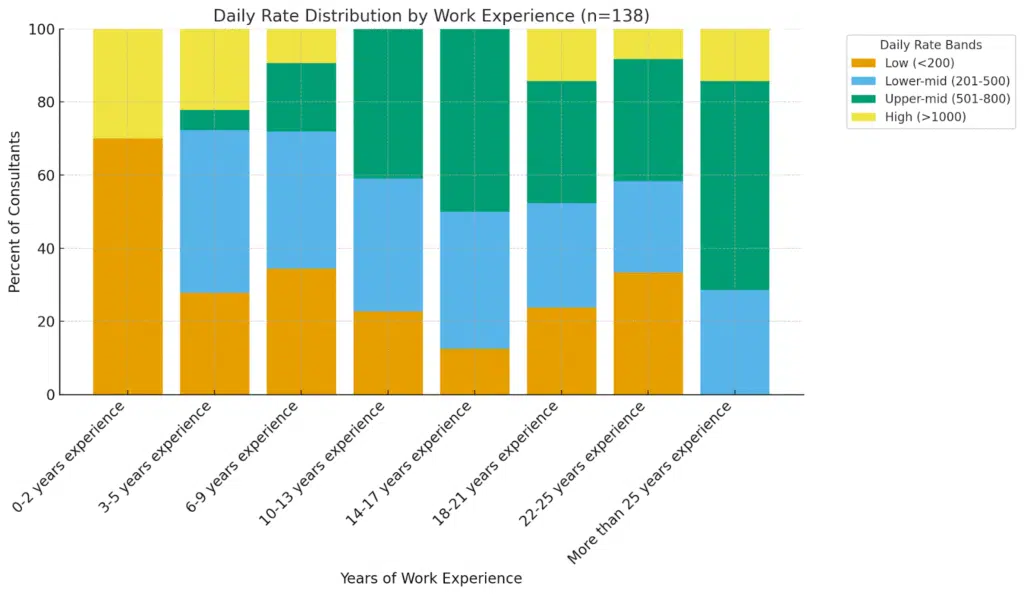
Which factors have had the greatest impact on the rates you’re able to charge in your consulting work?
Respondents identify client type and professional expertise as the strongest drivers of daily rates, both averaging above 3.7 in perceived impact. Mid-range influences include the complexity and length of assignments, as well as market demand and negotiation confidence, which shape rates but to a lesser degree. Factors such as assignment type, previous rate history, or logistical considerations (location, travel) are rated as less significant overall. This hierarchy suggests that who the client is and what expertise the consultant offers matter most, while operational or contextual factors tend to play a supporting role.
Respondents identified a clear hierarchy of influences, with client type and professional expertise topping the list. Other considerations, such as market demand, assignment length, and negotiation confidence, also play a role, while logistical elements like location or travel requirements tend to have less impact overall. Based on the survey, the factors with the greatest average impact on consulting rates are:
Type of client (NGO, IO, Business, etc.) – 3.77
Experience and expertise – 3.71
Complexity or technicality of the assignment – 3.30
Length of assignment – 3.20
Demand in the market for your skillset – 3.10
Ability/confidence in negotiating fees – 3.10
Lower-impact factors included client’s geographic location – 2.89
Whether work is remote or involves travel – 2.73
What challenges have you experienced as a consultant?
Consulting in the human rights field offers flexibility, variety, and purpose, but the survey makes clear that it also comes with significant challenges.
The most widespread difficulties are structural: nearly two-thirds of consultants face unpredictable or irregular work opportunities, while a similar share highlight the lack of salary and fee transparency that makes it harder to benchmark fair rates. More than half of respondents report pressure to accept lower fees for mission-driven work, and one in two struggle with negotiating fair compensation. Beyond pay, the realities of consulting bring operational frustrations: scope creep and unclear expectations (43%), lack of client feedback (38%), and delayed payments (37%) all emerged as common pain points. Personal impacts are also evident, with over a third citing difficulties balancing workload and life. While fewer consultants reported issues with contracts or expense reimbursement, these still affect a notable minority.
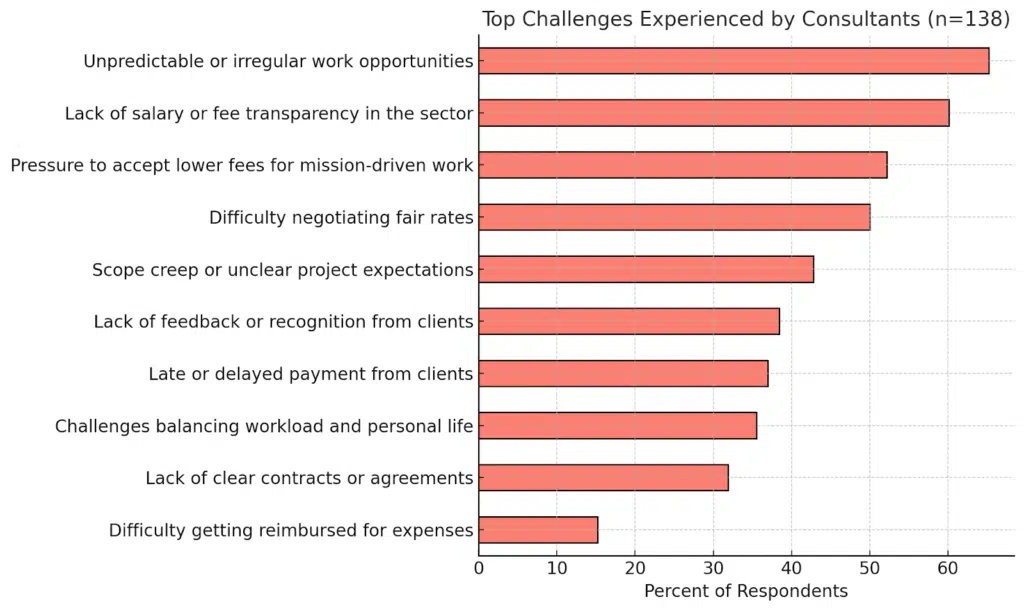
Summary
- The biggest challenges are unpredictable or irregular work opportunities (65.2%) and lack of salary/fee transparency (60.1%).
- Over half of respondents also cited pressure to accept lower fees (52.2%) and difficulty negotiating fair rates (50%).
- Operational issues like scope creep (42.8%), lack of feedback (38.4%), and late payments (37%) follow closely.
- Personal/workload balance and contract issues are significant for a third of consultants, while expense reimbursement (15.2%) is less common but still notable.
What kinds of support or resources would help you feel more confident in setting and negotiating your rates?
While client type, specialization, and expertise shape what consultants can charge, many human rights professionals still feel uncertain about whether their rates are fair or sustainable. This uncertainty often makes fee negotiations stressful in a sector where mission-driven work can pressure consultants to accept lower rates. In response to the open-ended question about what would help them feel more confident in setting and negotiating rates, the most common theme was greater transparency: almost one in five respondents asked for access to data on rates and salaries, whether through benchmarking studies, regional comparisons, or sector-wide guidelines.
Others pointed to the need for mentorship and guidance (7.3%), negotiation training and resources (5.1%), and clearer industry standards (1.5%). Smaller groups emphasized the value of peer networks and community support (1.5%), as well as practical tools such as templates and frameworks for setting fees.
Together, these responses suggest that consultants want both hard data and collective knowledge: tools to benchmark fairly, guidance to strengthen their confidence, and stronger professional communities to normalize transparent and sustainable pay across the human rights consulting sector. Do you know of any other resources that fall into these categories? Let us know so we can add them in this article.
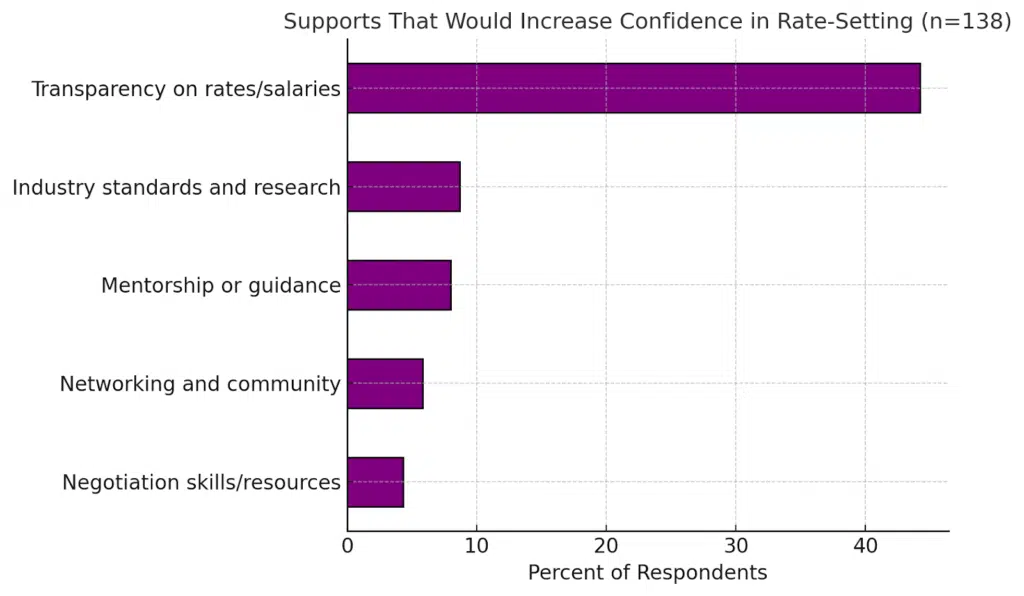
Additional resources:
– Impact Consulting Hub has conducted a very useful similar survey with 29 participants in 2022 for the International Development community.

